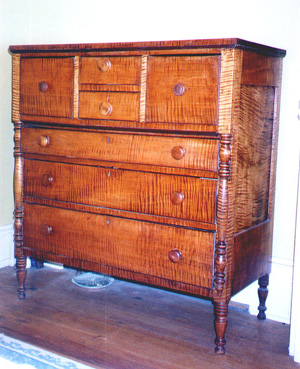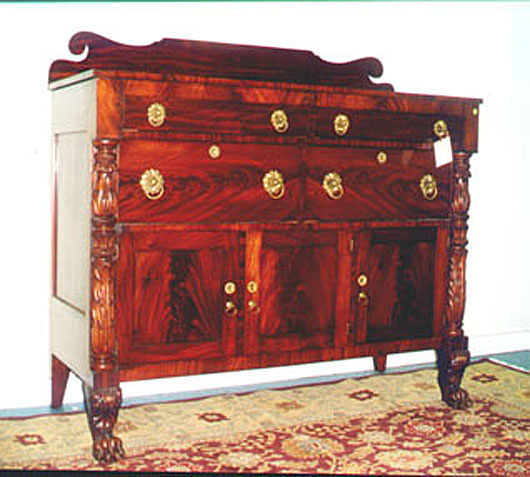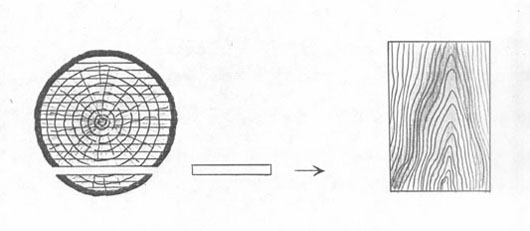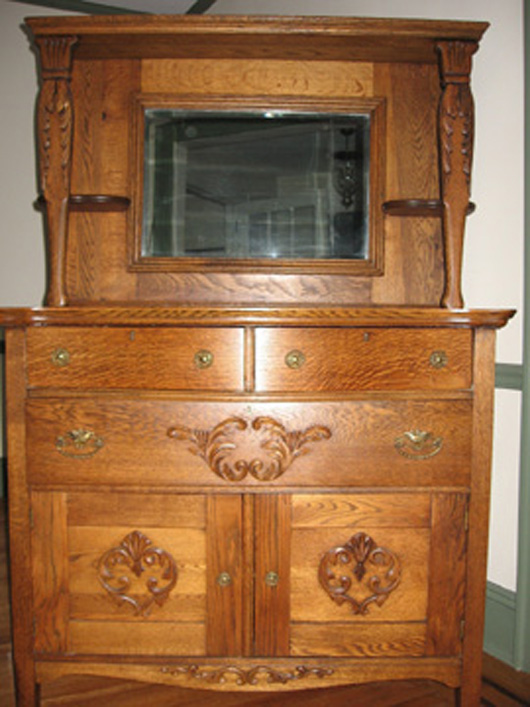
My mission is to spread a little of my accumulated knowledge to anyone interested in the subject of older and antique furniture so on with the task. Like any reasonably narrowly focused field, old furniture has its own vocabulary and many of the terms and their origins are not immediately obvious and seldom completely understood or used in the right context. But if they are used correctly they can accurately describe a piece of furniture without benefit of a picture. Photos are always better but the right words are a very good start. One of the more frequent instances of misuse of terms occurs when someone tries to describe the type of wood used in a piece. And I don’t mean the species of the wood – mahogany, oak walnut, etc. I mean the actual description of what the wood looks like. In more exact terms – how the wood was cut.
One of the most striking cuts of wood used in formal pieces is seen in fine furniture from the late 18th century and was used profusely well into the 19th. Mahogany is a beautiful wood no matter how it is cut but there is a way to cut it that produces a figure in the wood that resembles flames or feathers. Veneer with this sort of pattern is often book matched on drawer fronts or drop fronts to create a surface that not only is breathtaking in its figure and symmetry but it actually shimmers as you walk around it. If you spend any time looking at advertisements for antique auctions, visit the current offerings of traditional furniture on eBay or even read the local classifieds, you will inevitably come across a piece that has this cut of mahogany on it and the description will include the words “burl mahogany.” But it is not “burl” anything. Flame mahogany is produced by a method called a “crotch cut.” The wood literally is cut from the crotch formed where a limb branches from the trunk or where the trunk splits in two. The grain pattern is very confused with grain running in all directions producing the flames or feathers that seem to stem from a central line. This profusion of grain direction is also what produces the shimmer effect in the wood. Light areas turn dark and dark areas lighten up as your angle of observation changes. Walnut is also sometimes crotch cut as are birch and maple. They all produce a version of the flames and feathers seen in crotch cut mahogany. However, the cut that produces the attractive profusion and confusion of the grain direction also produces a piece of wood that is not very stable. That’s why almost every example of crotch cut wood is seen as a sheet of veneer glued to a stable background.
If that is “crotch cut” then what is burl? Burl is a growth anomaly in the wood itself characterized by a dark convoluted grain pattern usually against a lighter background. The overall effect seems to be that of a series of circles and loops intertwined randomly. Burl is even more unstable than crotch cut wood so it is never seen as other than veneer except in the occasional tobacco pipe. The most frequently seen burl is walnut burl used as decoration on 19th-century Victorian pieces, but burl can also be harvested from ash and oak as well. True walnut burl became scarce and expensive in the latter part of the 20th century, and Carpathian elm burl was used by many restoration and repair craftsman as a substitute to simulate the look of the 19th century.
Another method that produces an unusually attractive grain pattern from a relatively plain wood is called “quarter cutting” or quarter sawing.” This refers to how and where a plank is cut from a log. The accompanying illustration shows an oak log that has been cut into four sections, the quarters. Each quarter is then cut in a manner to produce the most number of planks with the greatest percentage of grain pattern at right angles to the plank surface. The other illustration shows how a log is flat cut, producing the largest number of wider boards no matter what the direction of the grain.
Quarter sawing has two advantages. First, since the majority of the grain pattern intersects the plank surface at a right angle there is less of tendency for the board to “cup” or warp following the grain pattern as it shrinks. A flat cut board with the grain running more or less parallel to the surface tends to cup more readily. The other advantage to the quarter cutting method is the exposure of the medullary rays. In a hardwood tree the primary grain conducts moisture up and down the trunk vertically, nourishing the leaves and new growth. But what feeds the soft inner core of the exterior bark, called the cambium? This layer of living tree is nourished by a set of horizontal grains running from the pith to the outer edge. These are the medullary rays. When a log is quarter cut some number of the rays are exposed, resulting in the large smooth sections of the wood called “flakes.” These flakes produce a pattern, especially in oak, that is often called “tiger eye” or cat’s eye.” This pattern of cutting to produce a figure was especially popular in oak furniture around the turn of the 20th century in the “golden oak” period. Quarter cutting a log is not as efficient in total board feet of lumber produced so it is seldom practiced today with the exception of producing oak lumber for the hardwood flooring industry. It takes a very old tree to have sufficiently large medullary rays to produce the tiger eye pattern so less and less of it is seen in modern furniture production.
Finally there is the maple tree. Maple trees voluntarily and naturally produce two interesting patterns in milled lumber, both apparently without external cause and both nearly undetectable before cutting. One pattern is seen in rock maple or sugar maple lumber and is known as “curly” or “tiger” maple because of the brown stripes running through the normal grain pattern. These stripes appear even on plain sawn surfaces for no apparent reason other than marking the growth rings. Curly maple was highly prized by Federal-era cabinetmakers. The other, even more mysterious, pattern in maple is the “bird’s-eye” phenomenon. This pattern consists of a series of individual “eyes” imbedded in the background grain pattern. There is no explanation of why this appears only in a few trees and only in a limited number of locations in Canada and the northeastern United States.
A working knowledge of the vocabulary of wood and veneer cutting techniques will enhance your ability to accurately describe and identify many pieces of antique furniture.
Send comments, questions and pictures Fred Taylor, P.O. Box 215, Crystal River, FL 34423 or info@furnituredetective.com.
Visit Fred’s website at www.furnituredetective.com. His book How To Be a Furniture Detective is available. Send check or money order for $21.95 to Fred Taylor, P.O. Box 215, Crystal River, FL 34423.
Fred and Gail Taylor’s dvd, Identification of Older and Antique Furniture ($17 + $3 S&H) and a bound compilation of the first 60 columns of Common Sense Antiques by Fred Taylor ($25 + $3 S&H) are also available at the same address. For more information call (800) 387-6377, fax 352-563-2916 or info@furnituredetective.com. All products are also available directly from the website.
ADDITIONAL IMAGES OF NOTE






